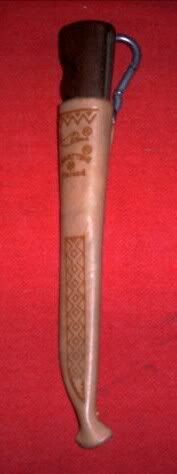Here is a 'puukko' style knife I made that's one of my handiest and most used knives.
I normally use this 3-3/4" blade as my auxiliary 'neck knife' when I'm in the bush or I'll use a small, strong carabineer style clip and attach it to my gear, shirt, belt, etc. It's handy, light, and you can just clip it anywhere.
I find that this knife compliments my other knives for use in camp, woodcraft, and in disassembling various critters such as fish, javelina, elk, and deer, especially for a few critical initial cuts that need to be made in most larger game. It also works well as a 'caping' knife. In the days of the mountain men, this would probably fall under the heading of a 'patch knife'. The 0170-6C, high carbon, chrome vanadium tool steel (the same used by Becker and Marbles) and the very good temper in this knife is first rate and very, very tough, which is typical of the older, carbon steel Western blades.
I originally made it as a 'karda' knife for a Nepalese khukuri I've been known to carry with me on forays out into the bush. I wound up liking it so much I made another karda for the khukuri and started packing this around as a separate knife.
I made the puukko from an old Western L66 bare blade made of tempered 0170-6C steel I had laying around that was given to me as 'junk' (someone else's knife project gone wrong). The handle I made out of a salvaged hickory carpenter's hammer handle I re-carved, and after the knife was together I hand rubbed it with Old English furniture polish for several coats and then soaked it for 48 hours in boiled linseed oil.
The blade I slowly re-ground keeping it cool all the while into a slender spear/drop point. The sheath is scavenged off of a 4" Rapala filet knife, the hanger was removed, and a small split ring was put in it's place for use with either a neck lanyard or a carabineer.
The blade is solidly affixed to the wood with JB Weld steel epoxy, and because it was laid into the handle with the 'slit trench' method, there are no air pockets. The last time I tried to remove a handle put on a blade like this with JB Weld, I had to grind the entire thing off millimeter by millimeter. There are also some small pin holes in the knife tang for the JB Weld to run through and 'grab' the tang.




I normally use this 3-3/4" blade as my auxiliary 'neck knife' when I'm in the bush or I'll use a small, strong carabineer style clip and attach it to my gear, shirt, belt, etc. It's handy, light, and you can just clip it anywhere.
I find that this knife compliments my other knives for use in camp, woodcraft, and in disassembling various critters such as fish, javelina, elk, and deer, especially for a few critical initial cuts that need to be made in most larger game. It also works well as a 'caping' knife. In the days of the mountain men, this would probably fall under the heading of a 'patch knife'. The 0170-6C, high carbon, chrome vanadium tool steel (the same used by Becker and Marbles) and the very good temper in this knife is first rate and very, very tough, which is typical of the older, carbon steel Western blades.
I originally made it as a 'karda' knife for a Nepalese khukuri I've been known to carry with me on forays out into the bush. I wound up liking it so much I made another karda for the khukuri and started packing this around as a separate knife.
I made the puukko from an old Western L66 bare blade made of tempered 0170-6C steel I had laying around that was given to me as 'junk' (someone else's knife project gone wrong). The handle I made out of a salvaged hickory carpenter's hammer handle I re-carved, and after the knife was together I hand rubbed it with Old English furniture polish for several coats and then soaked it for 48 hours in boiled linseed oil.
The blade I slowly re-ground keeping it cool all the while into a slender spear/drop point. The sheath is scavenged off of a 4" Rapala filet knife, the hanger was removed, and a small split ring was put in it's place for use with either a neck lanyard or a carabineer.
The blade is solidly affixed to the wood with JB Weld steel epoxy, and because it was laid into the handle with the 'slit trench' method, there are no air pockets. The last time I tried to remove a handle put on a blade like this with JB Weld, I had to grind the entire thing off millimeter by millimeter. There are also some small pin holes in the knife tang for the JB Weld to run through and 'grab' the tang.





